Rooftop Vertical Axis Wind Turbines (VAWTs) offer a compact, clean energy solution for your home. They're ideal for urban settings, capturing wind from any direction and operating quietly. To install one, you'll need to assess your roof's wind conditions and structural integrity, choose the right VAWT model, and gather necessary tools and safety gear. Proper installation and maintenance are essential for maximizing energy output and ensuring longevity. You'll also need to navigate local regulations and obtain required permits. While the initial investment can be significant, VAWTs can lead to substantial long-term energy savings. There's much more to discover about harnessing wind power at home.
Understanding Vertical Axis Wind Turbines

Vertical Axis Wind Turbines (VAWTs) stand out from their horizontal counterparts, spinning around a vertical shaft rather than a horizontal one. This unique design allows them to capture wind from any direction, making them ideal for urban environments with turbulent wind patterns.
VAWTs come in two main types: Savonius and Darrieus. Savonius turbines use cup-shaped blades to catch the wind, while Darrieus turbines have curved blades that generate lift.
You'll find that VAWTs have several advantages for rooftop installations. They're typically smaller and more compact than horizontal turbines, making them less visually intrusive. Their lower profile also reduces noise and vibration, which is essential in residential areas. VAWTs can start generating electricity at lower wind speeds, increasing their efficiency in areas with less consistent wind.
However, VAWTs aren't without drawbacks. They're generally less efficient than horizontal turbines in high wind speeds and may produce less overall power.
You'll need to take into account your specific location, wind patterns, and energy needs when deciding if a VAWT is right for your rooftop. Despite these limitations, VAWTs offer a viable option for clean energy production in urban and suburban settings.
Benefits of Rooftop VAWTs
You'll find several advantages to installing a Vertical Axis Wind Turbine (VAWT) on your rooftop.
The compact design of VAWTs makes them ideal for urban settings, allowing you to harness wind energy even in tight spaces.
You'll enjoy reduced energy costs and minimal noise pollution, making rooftop VAWTs an attractive option for both residential and commercial buildings.
Energy Cost Savings
Slashing your electricity bills is one of the most compelling reasons to install a rooftop VAWT. By generating your own clean energy, you'll reduce your reliance on the grid and potentially save hundreds of dollars annually. The exact savings depend on factors like wind conditions, turbine efficiency, and local electricity rates.
VAWTs can produce electricity 24/7, unlike solar panels, which only work during daylight hours. This constant energy generation can greatly offset your power consumption, especially during peak usage times. You might even generate excess electricity, which you can sell back to the grid through net metering programs, further increasing your savings.
Over time, the initial investment in a rooftop VAWT can pay for itself through reduced energy bills. Many homeowners see a return on investment within 5-10 years, after which the savings continue to accumulate.
Additionally, as electricity prices rise, your savings will likely increase proportionally. By installing a VAWT, you're not only cutting costs but also insulating yourself against future energy price hikes, providing long-term financial benefits and energy independence.
Low Noise Pollution
Unlike their horizontal-axis counterparts, vertical-axis wind turbines (VAWTs) are known for their quiet operation, making them an excellent choice for residential areas. You'll appreciate the low noise pollution that VAWTs produce, especially when installed on your rooftop.
The vertical design of these turbines allows for smoother rotation, resulting in considerably less noise compared to traditional windmills.
VAWTs typically generate sound levels between 35 and 50 decibels, which is comparable to a quiet conversation or the hum of a refrigerator. This means you can harness wind energy without disturbing your neighbors or disrupting your own peace and quiet.
The low noise output is particularly beneficial in urban settings where noise regulations are often stricter.
The quieter operation of VAWTs is due to several factors, including their lower tip speed ratio and the absence of blade pitch changes. This design also reduces vibrations, further minimizing noise transmission through your home's structure.
Compact Urban Installation
Rooftop VAWTs offer a perfect solution for urban dwellers looking to harness wind energy in tight spaces. These compact turbines are designed to fit on limited roof areas, making them ideal for apartment buildings, office complexes, and homes with small footprints.
Unlike their horizontal-axis counterparts, VAWTs don't require extensive open space or tall towers, allowing you to generate clean energy without compromising your urban lifestyle.
The vertical design of these turbines means they can be installed closer together, maximizing energy production in confined areas. You'll find that VAWTs are also easier to integrate into existing architecture, often blending seamlessly with urban aesthetics.
Their compact nature simplifies installation and maintenance processes, reducing costs and logistical challenges associated with larger wind turbines.
Moreover, rooftop VAWTs can take advantage of the urban wind environment, which is often characterized by turbulent and changing wind directions. This adaptability guarantees consistent energy production even in less-than-ideal wind conditions.
Assessing Your Rooftop's Suitability
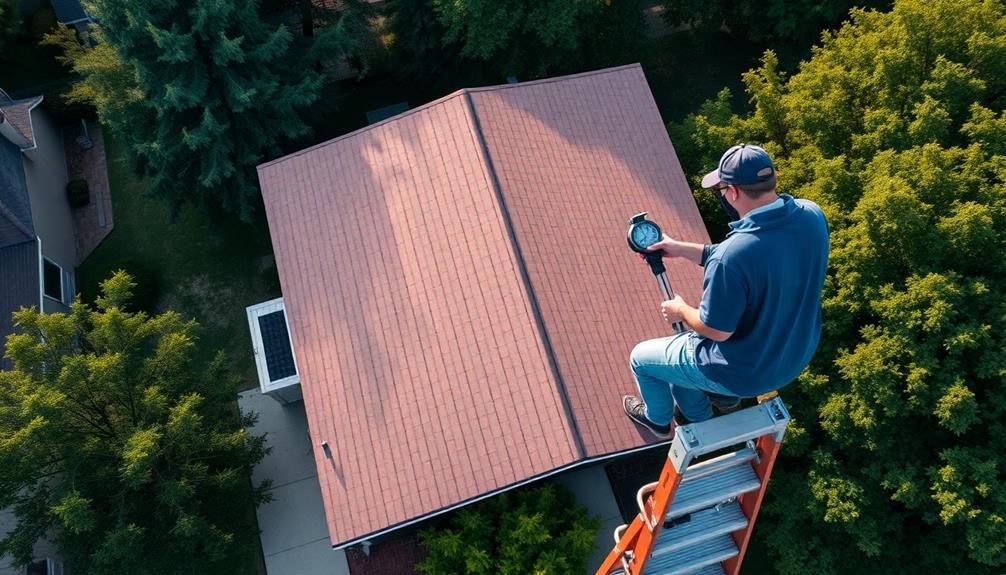
Before installing a rooftop VAWT, you'll need to assess your location's suitability.
Start by evaluating the average wind speeds at your rooftop height, as this will determine the turbine's potential energy output.
Next, have a professional check your roof's structural integrity to guarantee it can support the added weight and vibrations.
Wind Speed Evaluation
Evaluating wind speed is essential when appraising your rooftop's suitability for a Vertical Axis Wind Turbine (VAWT). To accurately assess wind conditions, you'll need to collect data over an extended period.
Start by installing an anemometer on your roof to measure wind speed and direction. Record measurements for at least six months to a year to capture seasonal variations.
Most VAWTs require average wind speeds of 9-11 mph (4-5 m/s) to generate electricity efficiently. However, some models can operate at lower speeds.
Check your local weather station for historical wind data, but remember that urban environments can greatly affect wind patterns.
Consider using wind mapping tools or consulting with a wind energy specialist to get a more precise assessment of your site's wind potential. They can help you analyze factors like turbulence, wind shear, and local terrain that may impact your VAWT's performance.
Don't forget to check local zoning laws and building codes, as they may restrict the height and placement of wind turbines. Some areas require permits or have specific regulations for rooftop installations.
Structural Integrity Check
After evaluating wind conditions, you'll need to determine if your roof can support a VAWT. This structural integrity check is vital for safety and ideal performance. Start by examining your roof's age, condition, and material. Older roofs or those in poor condition may require reinforcement or replacement before installation.
Next, assess your roof's load-bearing capacity. VAWTs can weigh anywhere from 100 to 500 pounds, so your roof must be able to handle this additional weight. Consider factors like snow load in your area, which can add significant weight during winter months.
Here's a quick reference guide for roof types and their suitability for VAWTs:
| Roof Type | Load Capacity | VAWT Suitability |
|---|---|---|
| Asphalt Shingle | Moderate | Good |
| Metal | High | Excellent |
| Tile | Low to Moderate | Fair |
| Flat/Built-up | High | Excellent |
If you're unsure about your roof's structural integrity, consult a professional structural engineer. They can provide a thorough assessment and recommend any necessary reinforcements. Don't skip this step – it's essential for your safety and the longevity of both your VAWT and your home.
Local Regulations Research
Once you've confirmed your roof's structural integrity, it's vital to explore local regulations governing rooftop wind turbines. Many municipalities have specific rules about installing renewable energy systems on residential buildings. Start by contacting your local planning department or zoning office to inquire about permits, restrictions, and guidelines for rooftop VAWTs.
During your research, pay close attention to:
- Height restrictions: Some areas limit the total height of structures, including rooftop additions.
- Noise regulations: Check if there are decibel limits for residential areas, as some VAWTs can produce noise.
- Setback requirements: Understand how far the turbine must be from property lines or neighboring buildings.
Don't forget to investigate homeowners' association (HOA) rules if you live in a managed community. Some HOAs have strict guidelines about exterior modifications, including renewable energy installations.
Be prepared to present detailed plans and specifications to your local authorities and HOA board. It's imperative to obtain all necessary approvals before proceeding with your VAWT installation to avoid potential legal issues or fines.
Choosing the Right VAWT Model
Selecting the right Vertical Axis Wind Turbine (VAWT) model is essential for maximizing your rooftop energy production. Consider factors like wind speed, available space, and power requirements when choosing your VAWT. Research different types, such as Savonius and Darrieus models, to determine which best suits your needs.
Evaluate the turbine's rated power output, cut-in speed, and noise levels. Opt for models with low cut-in speeds if you live in an area with moderate wind conditions. Pay attention to the turbine's size and weight to guarantee it's compatible with your roof's structure and local building codes.
Look for VAWTs with high efficiency ratings and durable construction materials like fiberglass or carbon fiber. Consider models with built-in safety features, such as automatic braking systems for high wind speeds.
Don't forget to check the warranty and after-sales support offered by manufacturers. Compare prices and long-term energy savings to determine the most cost-effective option.
Read customer reviews and seek recommendations from renewable energy professionals to make an informed decision. Remember, the ideal VAWT should balance performance, durability, and compatibility with your specific rooftop conditions.
Required Tools and Materials
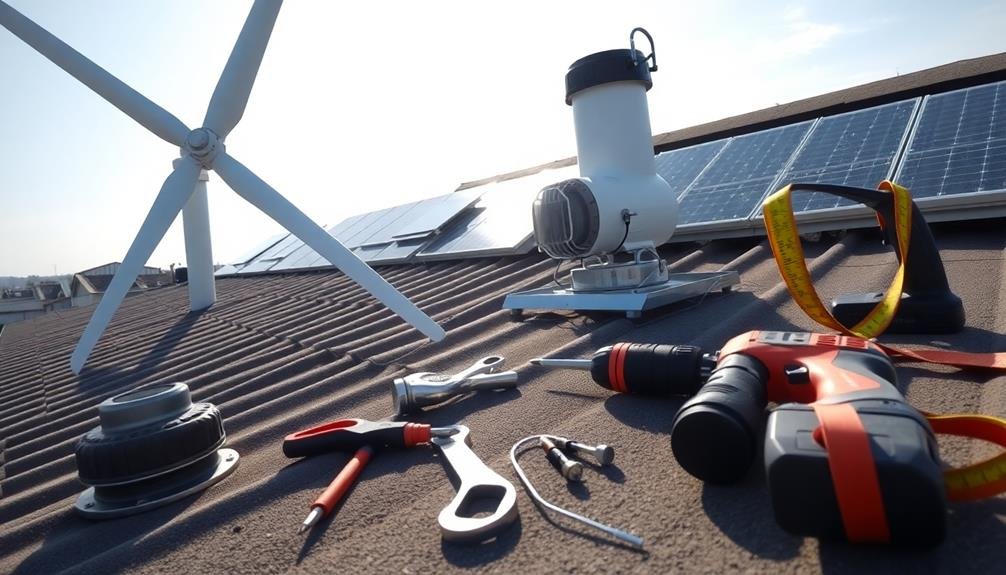
Before you begin installing your rooftop VAWT, you'll need to gather the essential equipment and tools for the job.
Don't forget to prioritize safety by preparing a thorough checklist of protective gear.
You'll also want to make certain you have all the necessary electrical components on hand to complete the installation successfully.
Essential Installation Equipment
To get your rooftop VAWT project off the ground, you'll need to round up the right tools and materials. Essential installation equipment includes both specialized items for wind turbine assembly and common tools you might already have in your toolbox.
Start by gathering safety gear like hard hats, work gloves, and non-slip shoes to protect yourself during the installation process.
For the actual VAWT setup, you'll need:
- A mounting kit specific to your turbine model
- Weatherproof electrical wiring and connectors
- An inverter to convert DC power to AC for home use
Don't forget basic tools such as wrenches, screwdrivers, and a drill with various bits.
You'll also need a sturdy ladder or scaffolding to safely access your roof. A level is vital for ensuring your VAWT is properly aligned, while a multimeter will help you test electrical connections.
Consider renting or borrowing specialized equipment like a torque wrench or wire crimpers if you don't plan on using them regularly.
Remember to check your local building codes and obtain any necessary permits before beginning the installation.
With all your equipment ready, you'll be well-prepared to tackle your rooftop VAWT project efficiently and safely.
Safety Gear Checklist
Safety comes first when installing a rooftop VAWT, and you'll need five essential pieces of gear to protect yourself. Start with a sturdy safety harness and lanyard system to prevent falls. Confirm the harness fits properly and is rated for your weight.
Pair this with non-slip safety boots that provide excellent traction on various roofing materials.
A hard hat is vital to protect your head from falling objects or accidental bumps. Choose one that's comfortable and meets OSHA standards.
Don't forget safety glasses to shield your eyes from debris, wind, and glare. Opt for impact-resistant lenses with UV protection.
Lastly, invest in high-quality work gloves that offer both dexterity and protection. Look for gloves with reinforced palms and fingertips to handle tools and equipment safely. Consider cut-resistant gloves if you'll be working with sharp edges.
Before ascending to the roof, double-check that all your safety gear is in good condition and properly fitted. Regularly inspect and replace worn items to maintain peak protection throughout the VAWT installation process.
Electrical Components Needed
With your safety gear ready, it's time to gather the electrical components for your rooftop VAWT installation. You'll need a variety of parts to guarantee your wind turbine can effectively generate and transmit power.
Start by acquiring a generator or alternator suited to your VAWT's size and expected output. Next, you'll need a charge controller to regulate the power flow and protect your batteries from overcharging.
For storing the energy produced, invest in deep-cycle batteries designed for renewable energy systems. Don't forget an inverter to convert DC power to AC for household use. You'll also need various cables, connectors, and fuses to safely wire your system together.
To complete your electrical setup, make sure you have:
- A weatherproof junction box for outdoor connections
- A disconnect switch for safety and maintenance
- A power meter to monitor your system's performance
Remember to choose components rated for outdoor use and compatible with your VAWT's specifications.
If you're unsure about any electrical aspects, it's wise to consult a professional electrician to guarantee your system is safe and compliant with local regulations.
With these components in hand, you'll be ready to harness clean wind energy from your rooftop VAWT.
Safety Precautions for Installation
Three critical safety precautions must be followed when installing a rooftop VAWT.
First, verify you're working with a sturdy, well-maintained roof that can support the turbine's weight and withstand its vibrations. Have a professional inspect your roof's structural integrity before proceeding.
Second, prioritize fall protection. Use a safety harness and secure anchor points when working at height. Install temporary guardrails or use a fall arrest system to prevent accidents. Never work alone on the roof; always have a spotter on the ground.
Third, be cautious of electrical hazards. Turn off the main power supply before connecting any wiring. Use insulated tools and wear rubber-soled shoes to reduce the risk of electric shock. If you're not confident in your electrical skills, hire a licensed electrician.
Additional precautions include checking weather forecasts to avoid installation during high winds or storms, using proper lifting techniques when handling heavy components, and keeping your work area clean and organized to prevent tripping hazards.
Always wear appropriate personal protective equipment, including a hard hat, safety glasses, and non-slip gloves. By following these safety measures, you'll minimize risks and verify a successful VAWT installation.
Step-by-Step Installation Process
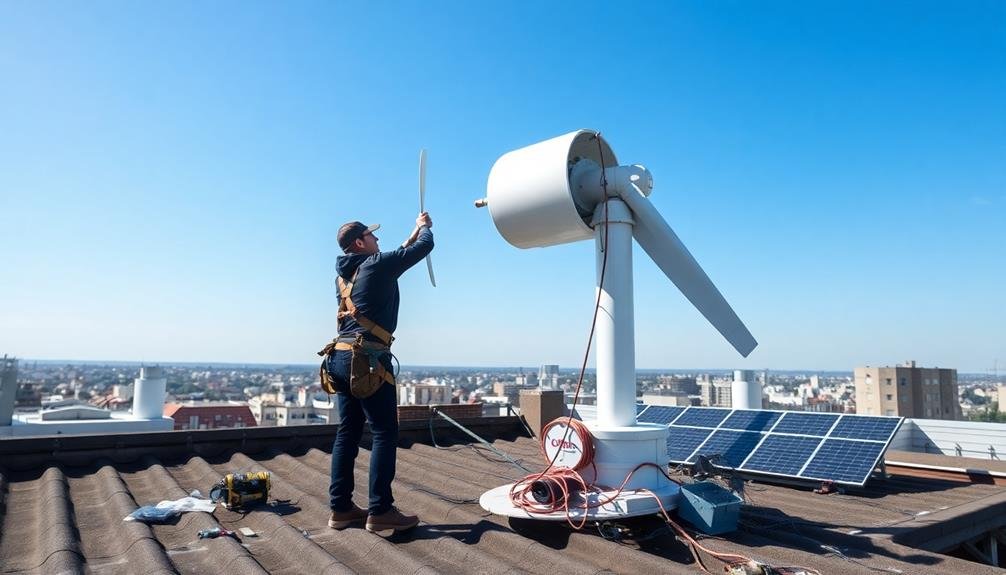
Diving into the step-by-step installation process, you'll find that proper planning and execution are key to a successful rooftop VAWT setup.
Begin by evaluating your roof's structure and determining the ideal location for your turbine. Next, gather all necessary tools and materials, including the VAWT kit, mounting brackets, and electrical components.
Start the installation by securing the mounting base to your roof, making certain it's level and properly sealed to prevent leaks. Then, assemble the turbine components according to the manufacturer's instructions.
Once assembled, carefully lift and attach the turbine to the mounting base, making sure it's securely fastened.
For the electrical setup:
- Install the charge controller and inverter in a protected area
- Connect the turbine to the charge controller using appropriate wiring
- Link the system to your home's electrical panel, following local codes
After completing the electrical connections, perform a thorough inspection of all components and connections.
Test the system to verify it's functioning correctly and monitor its performance over the first few days.
Remember to schedule regular maintenance checks to keep your rooftop VAWT operating efficiently and safely for years to come.
Connecting to Your Home's Electrical System
Connecting your rooftop VAWT to your home's electrical system is a critical step that requires careful planning and execution. First, consult a licensed electrician to guarantee compliance with local codes and regulations. They'll help you determine if your existing electrical panel can handle the additional power input or if you need an upgrade.
You'll need to install an inverter to convert the DC power generated by the turbine into AC power for your home. Choose an inverter that's compatible with your VAWT's output and your home's electrical system. The electrician will connect the turbine to the inverter and then to your main electrical panel.
Consider installing a battery backup system to store excess energy for use during low-wind periods or power outages. This requires additional equipment, including charge controllers and batteries.
Safety is paramount. Guarantee proper grounding of all components and install appropriate circuit breakers and disconnects.
You may also need to install a new meter to track energy production and consumption, especially if you plan to participate in net metering programs with your utility company.
Maintenance and Upkeep
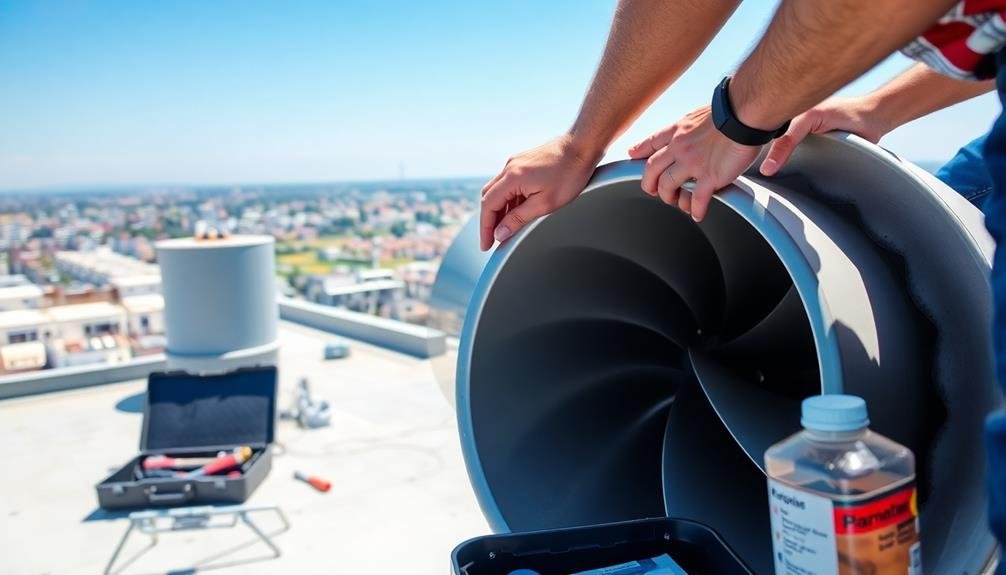
Regular maintenance is essential for keeping your rooftop VAWT operating efficiently and safely. You'll need to perform periodic inspections and upkeep tasks to guarantee your turbine's longevity and peak performance.
Start by visually checking the turbine blades, bearings, and mounting structure for any signs of wear, damage, or loose components. Clean the blades regularly to remove dirt, debris, and insects that can affect aerodynamics and efficiency.
Here are three critical maintenance tasks you shouldn't overlook:
- Lubricate moving parts according to the manufacturer's recommendations.
- Check and tighten all bolts and fasteners to prevent vibrations and potential failures.
- Inspect and clean the generator components, including brushes and slip rings.
Pay attention to unusual noises or vibrations during operation, as these can indicate potential issues.
Keep detailed records of your maintenance activities and any performance changes you observe. If you're not comfortable performing these tasks yourself, consider hiring a professional technician for annual inspections and servicing.
Maximizing VAWT Energy Output
To maximize your rooftop VAWT's energy output, you'll need to focus on several key factors. First, guarantee proper placement by choosing a location with unobstructed wind flow. Consider the prevailing wind direction and avoid turbulence-causing obstacles. Next, optimize your VAWT's height; generally, higher installations capture stronger winds.
Regular maintenance is essential for peak performance. Keep blades clean and balanced, and lubricate moving parts as recommended. Monitor your system's performance and address any issues promptly.
Consider implementing a hybrid system by combining your VAWT with solar panels. This can provide a more consistent energy supply throughout varying weather conditions.
| Optimization Strategy | Potential Benefit | Implementation Difficulty |
|---|---|---|
| Proper Placement | 15-25% increase | Moderate |
| Height Optimization | 10-20% increase | High |
| Regular Maintenance | 5-10% increase | Low |
| Blade Upgrades | 10-15% increase | Moderate |
| Hybrid System | 20-30% increase | High |
Lastly, stay informed about technological advancements in VAWT design. Upgrading to more efficient blades or controllers can greatly enhance your system's output. By implementing these strategies, you'll maximize your rooftop VAWT's energy production and enhance your home's renewable energy capabilities.
Troubleshooting Common Issues

Despite proper installation and maintenance, you may encounter some issues with your rooftop VAWT. Common problems include excessive noise, vibrations, and reduced power output.
To troubleshoot these issues, first check for loose components or debris that might be causing imbalance. Tighten any loose bolts and clean the turbine blades thoroughly.
If noise persists, consider installing vibration dampeners or repositioning the turbine to minimize sound reflection. For reduced power output, inspect the electrical connections and verify your inverter is functioning correctly. Clean or replace any corroded wiring, and confirm that your system is properly grounded.
When troubleshooting, always prioritize safety:
- Disconnect the turbine from the power system before inspecting
- Use proper safety equipment, including gloves and eye protection
- Consult a professional if you're unsure about any repairs or adjustments
If you've exhausted all troubleshooting options and the issue persists, contact the manufacturer or a certified technician. They can provide specialized diagnostics and repairs to get your VAWT back to ideal performance.
Regular monitoring and addressing issues promptly will help guarantee your rooftop VAWT continues to generate clean energy efficiently for years to come.
Local Regulations and Permits
Before installing a rooftop VAWT, you'll need to navigate local regulations and obtain necessary permits. Start by contacting your local planning department to understand zoning laws, height restrictions, and noise regulations. Many areas have specific rules for small wind turbines, which may differ from those for solar panels.
You'll likely need to submit an application detailing your VAWT's specifications, including its size, power output, and noise levels. Be prepared to provide engineering drawings and safety certifications. Some jurisdictions may require a site assessment or environmental impact study.
Here's a quick overview of common requirements:
| Permit/Regulation | Typical Requirements |
|---|---|
| Building Permit | Structural integrity |
| Electrical Permit | Grid connection specs |
| Zoning Approval | Height, setbacks |
| Noise Compliance | Decibel limits |
| HOA Approval | Aesthetic guidelines |
Don't forget to check if your area offers incentives for renewable energy installations. Some localities provide tax breaks or rebates for wind turbines. By thoroughly researching and complying with local regulations, you'll guarantee a smooth installation process and avoid potential legal issues down the line.
Cost-Benefit Analysis of Rooftop VAWTs
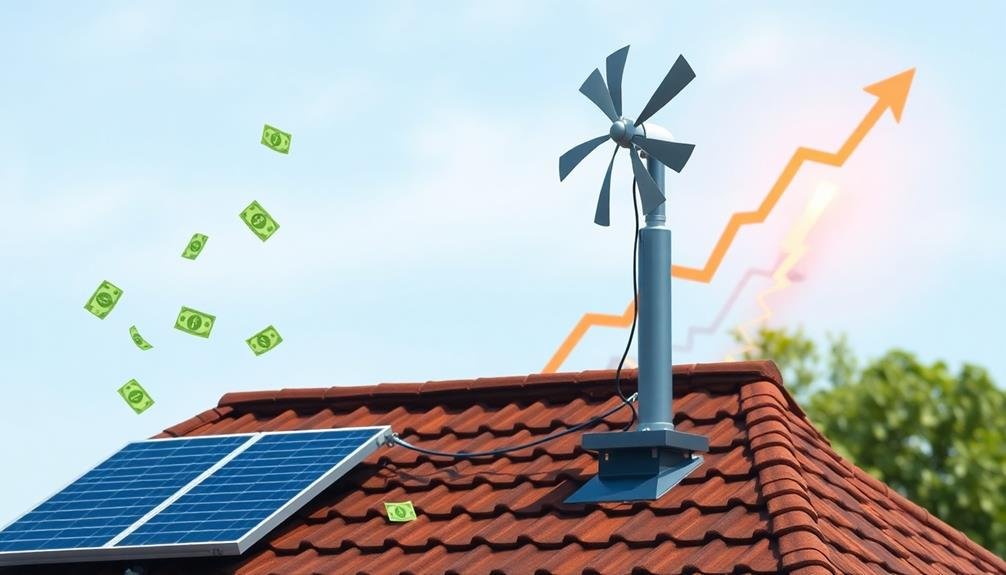
When considering a rooftop VAWT, it's crucial to conduct a thorough cost-benefit analysis. Start by calculating the initial investment, including the turbine, installation costs, and any necessary permits.
Next, estimate your potential energy savings based on local wind patterns and your current electricity rates. Don't forget to factor in maintenance costs and the expected lifespan of the system.
To determine if a rooftop VAWT is right for you, consider these key points:
- Payback period: Calculate how long it'll take for energy savings to offset the initial investment.
- Energy independence: Evaluate the potential reduction in your reliance on the grid and protection against rising utility costs.
- Environmental impact: Assess the reduction in your carbon footprint and potential green energy incentives.
Compare these benefits to alternative energy solutions, such as solar panels or traditional wind turbines.
Remember that VAWTs typically have lower efficiency than horizontal-axis turbines but may be better suited for urban environments.
Consider consulting with a renewable energy expert to help you make an informed decision based on your specific circumstances and energy goals.
Frequently Asked Questions
Can VAWTS Interfere With TV or Radio Signals?
You shouldn't worry too much about VAWTs interfering with TV or radio signals. They're unlikely to cause significant disruption. However, if you're concerned, place your VAWT away from antennas and consider using shielded cables.
How Long Does It Typically Take for a VAWT to Pay for Itself?
You'll typically see a VAWT pay for itself in 5-10 years, depending on factors like wind conditions, electricity rates, and installation costs. It's important to evaluate your specific situation when calculating the payback period.
Are There Any Bird-Friendly VAWT Designs Available?
Yes, there are bird-friendly VAWT designs available. You'll find options with enclosed blades or slower rotation speeds. Some models use visual deterrents or emit sounds to keep birds away. Always research and choose designs prioritizing wildlife safety.
Can I Install a VAWT on a Flat Roof?
Yes, you can install a VAWT on a flat roof. It's an ideal location, offering unobstructed wind flow. You'll need to guarantee your roof can support the weight and vibrations. Consult a structural engineer before proceeding.
Do VAWTS Work Well in Urban Environments With Unpredictable Wind Patterns?
VAWTs can work well in urban environments with unpredictable wind patterns. They're designed to handle turbulent winds from multiple directions. You'll likely see better performance than horizontal turbines, but energy output may still be inconsistent.
In Summary
You've now got the knowledge to harness clean wind energy right from your rooftop. By installing a VAWT, you're taking a big step towards energy independence and reducing your carbon footprint. Remember to assess your site carefully, choose the right model, and follow local regulations. While there's an upfront investment, the long-term benefits can be substantial. With proper maintenance, your rooftop VAWT will provide clean energy for years to come.



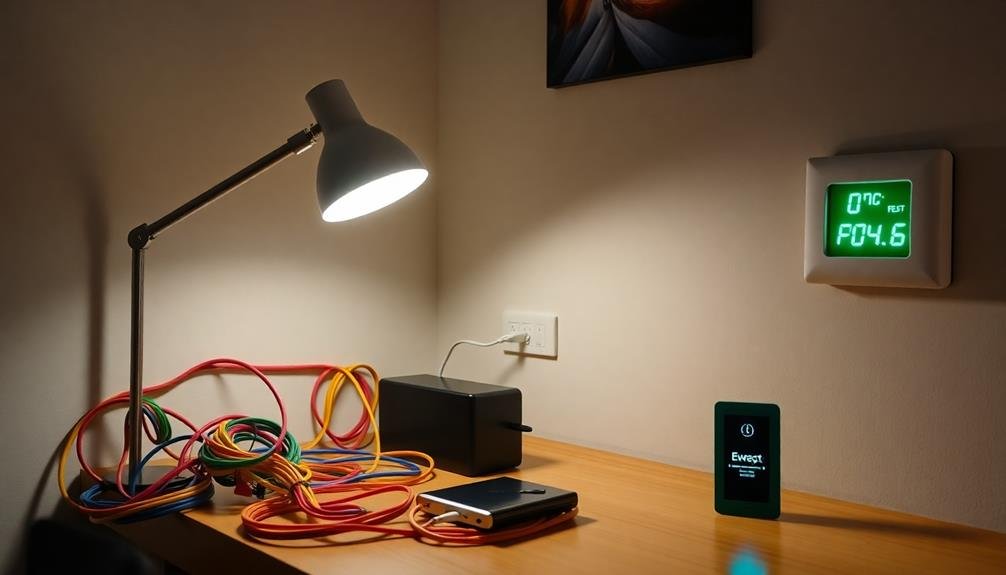

Leave a Reply